|
| Space Laboratory
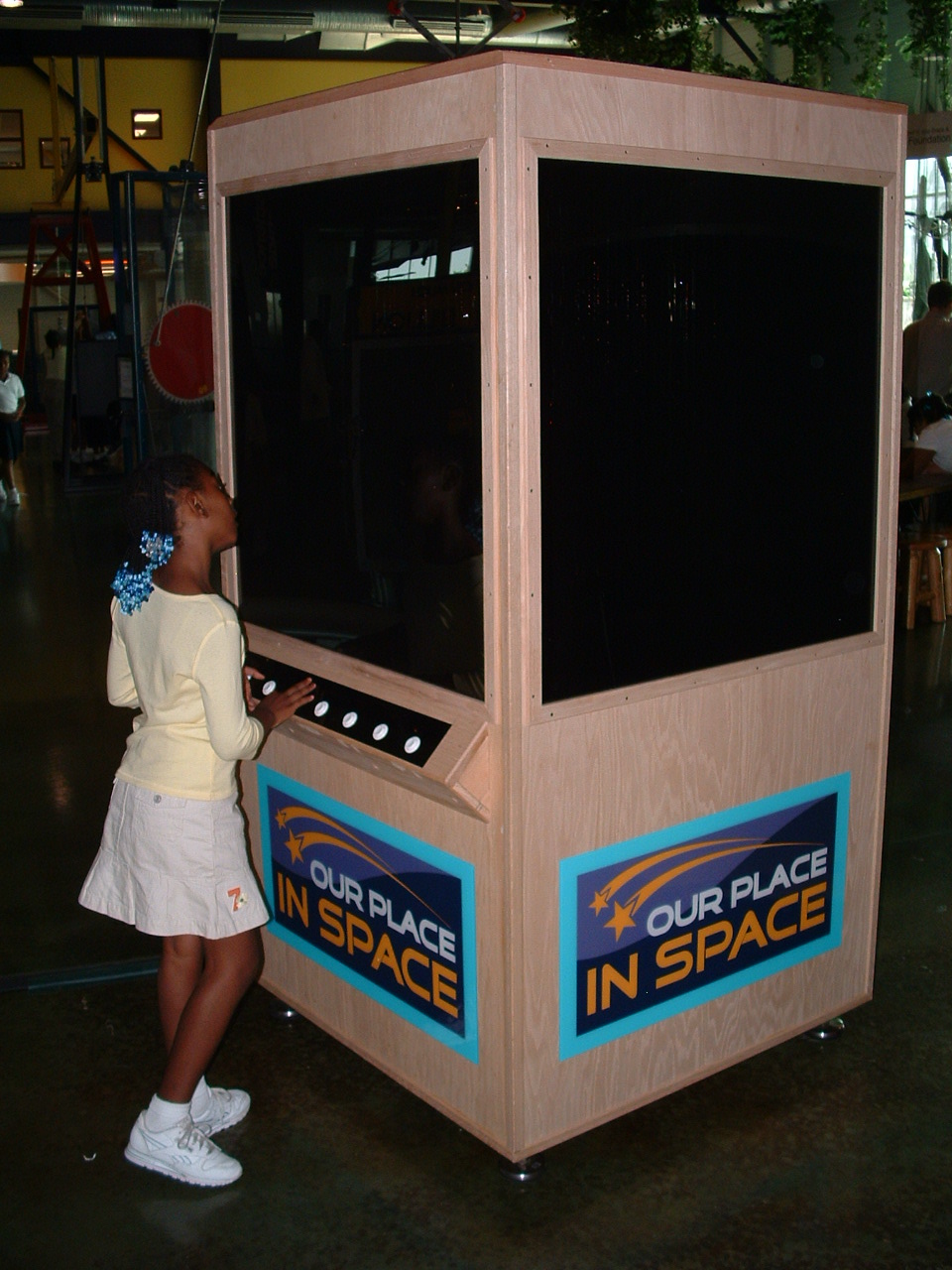 The
Space Laboratory offers exhibits that correlate to two themes from the
Michigan Curriculum Framework -- Content of the Universe and Scale of the
Universe. Exhibits in the Space Laboratory include three telescopes
positioned at varying heights that allow visitors to learn how astronomers
use telescopes to study distant objects, a Solar System Distance Scale where
visitors will be able to position each planet the correct scale distance
from the sun, the Our Place in the Sun, How Much is a Billion and the Are We
There Yet exhibits. Visitors also can see the newest images from the Hubble
Space Telescope and Spitzer Space Telescope, along with live NASA launches
and images from the International Space Station all in high definition video
on our giant video screen in front of the Dassault Syst�mes Planetarium. The
Space Laboratory offers exhibits that correlate to two themes from the
Michigan Curriculum Framework -- Content of the Universe and Scale of the
Universe. Exhibits in the Space Laboratory include three telescopes
positioned at varying heights that allow visitors to learn how astronomers
use telescopes to study distant objects, a Solar System Distance Scale where
visitors will be able to position each planet the correct scale distance
from the sun, the Our Place in the Sun, How Much is a Billion and the Are We
There Yet exhibits. Visitors also can see the newest images from the Hubble
Space Telescope and Spitzer Space Telescope, along with live NASA launches
and images from the International Space Station all in high definition video
on our giant video screen in front of the Dassault Syst�mes Planetarium.
This exciting space laboratory was created with the support of Congressman
Joe Knollenberg and funding from National Aeronautics and Space
Administration (NASA).
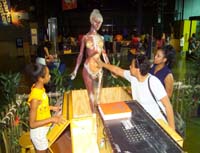 The Detroit Science Center's
exhibits life science explain the Laboratory explains the wonders of
nature with spectacular exhibits and interactive displays. Observe the similarities
between urban and rainforest ecosystems by comparing the wildlife that inhabits these
environments. Unleash the secrets of DNA and explore the workings of the microscopic
world. The Detroit Science Center's
exhibits life science explain the Laboratory explains the wonders of
nature with spectacular exhibits and interactive displays. Observe the similarities
between urban and rainforest ecosystems by comparing the wildlife that inhabits these
environments. Unleash the secrets of DNA and explore the workings of the microscopic
world.
Like the other Science Center laboratories, Life Sciences addresses subjects required
by the State of Michigan Curriculum Framework for Science Education, including cells, the
organization of living things, heredity and ecosystems.
Among the many exhibits, explore:
- Step Into Heart Health�-
a 1,200-square-foot exhibit with
interactive displays, quizzes and important heart health
information.
- TAM - our
transparent anatomical model (TAM) reveals the workings of the
human body.
- Eekstein's Workshop - a special area where visitors can
participate with various science-based activities and
demonstrations.
|
| Physical Science Exhibits |
|

Opens April 3!
With 39 hands-on exhibits spanning 2,800 square feet,
the Fun Factory will allow visitors to experience how the
manufacturing process turns ideas into reality with the aid of
computer design, prototypes, simulations, conveyors, robots,
statistics and more.
|
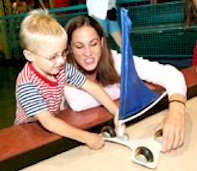
Motion
Motion exhibits incorporate content from the State of Michigan Curriculum Framework for Science
Education, including Speed and Direction, Changes in Motion and Unbalanced Forces.
The laboratory features interactive displays that demonstrate the principals of
motion, speed and direction.
Among the many exhibits are: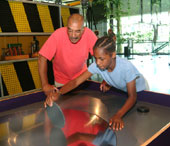
- It's Revolutionary - takes you into the world of pendulums and gyroscopic motion
with a three-story Foucault pendulum and a 1,700-pound flywheel.
- Cranks-a-Lot - reflects technology that drives the Motor City: Visitors provide
the force to power a giant V-4 engine, plus a wall that showcases ingenious gear ratios. A
power transmission shows methods used to convert one type of motion to another.
|
Matter and
Energy |
| |
 Matter and Energy exhibits demonstrate fundamental principals of
electricity and magnetism, energy conversion and the properties of matter. Visitors can
observe various forms of energy, the relationship between energy and magnetism, and
changes in matter and how they are related to changes in energy. Like the other
laboratories, Matter and Energy addresses subjects required by the Michigan Curriculum
Framework for Science Education, such as the transformation of energy; investigation,
description and analysis of energy; the transformation of matter; and the human
technological impact upon matter and energy. Matter and Energy exhibits demonstrate fundamental principals of
electricity and magnetism, energy conversion and the properties of matter. Visitors can
observe various forms of energy, the relationship between energy and magnetism, and
changes in matter and how they are related to changes in energy. Like the other
laboratories, Matter and Energy addresses subjects required by the Michigan Curriculum
Framework for Science Education, such as the transformation of energy; investigation,
description and analysis of energy; the transformation of matter; and the human
technological impact upon matter and energy.
Matter and Energy includes interactive tabletop exhibits to allow exploration of
circuits, electrical loads and patterns created by magnetic fields. How much energy is
required to power a small light bulb? Find out by operating a hand-crank generator.
Among the many exhibits in the Matter & Energy Laboratory, explore:
- The Hot Air Balloon - a balloon rises 30 feet to the ceiling above the seats of
the DaimlerChrysler Science Stage. The balloon rises because of heated air that is blown
inside. As the air cools, the balloon descends and the process repeats.
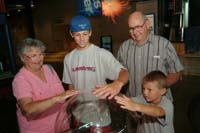
- The Tornado and Molecular Motion Chamber - demonstrates the relationship between
heat energy from the sun and weather processes. Temperature results from molecular action,
or vibration. The process is displayed within a chamber full of ball bearings that
represent molecules. The temperature in the chamber increases with the accelerated
vibration of the ball bearings.
- DTE Energy Sparks Theater - is an electrifying experience. Electricity earns its star billing as it sparks and dances to amaze Science Center visitors. The theater is contained
within a Faraday cage to ensure safe demonstration of lightning bolts, and is grounded
separately from the Science Center. A Tesla coil, can crusher and several other electrical phenomena
play supporting roles.
|
Waves &
Vibrations |
| |
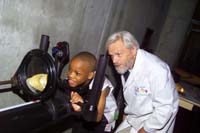 Light and sound are created by physical and electromagnetic
waves, which are featured in a series of highly sensory exhibits
that demonstrate the transfer of energy through wave motion. Light and sound are created by physical and electromagnetic
waves, which are featured in a series of highly sensory exhibits
that demonstrate the transfer of energy through wave motion.
Like the Science Center's other labs, Waves and Vibrations is
based on the State of Michigan Curriculum Framework for Science
Education. Subjects addressed include light and shadows, sound
waves, vibrations, waves, and the transfer of energy by waves and
vibrations.
Explore the electromagnetic spectrum at interactive tabletop
displays that investigate microwaves, radio waves, x-rays and
visible light. Discover how light reflects and how it is absorbed.
Sound wave displays look at the science of pitch, amplitude and
reflection. Visitors also can "play" with mechanical waves to
observe how they transfer energy, as well as explore the motion of
vibrating objects.
Among the many exhibits in Waves and Vibrations, explore:
- Slice of Light - Make light reflect, refract, absorb
and scatter. Experience the wonders of light though prisms,
lasers, fib
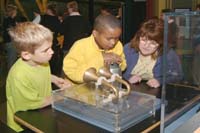 er optics and oscilloscopes. A lens wall, mirror wall
and a unique kaleidoscope further the excitement of light
exploration. er optics and oscilloscopes. A lens wall, mirror wall
and a unique kaleidoscope further the excitement of light
exploration.
- The Laser Harp - Combine the wonders of light and sound
waves. Get a "sound" reward by interrupting a laser beam.
- Play With Sounds - Play With Sounds offers a "sound"
playground. Raise your voice in song for a duet with a singing bowl. Whisper across a void and have fun with big (shive) waves.
What do tuning forks, Slinkies, vocal chords, piano strings with
oscilloscopes and weights on a spring have in common? Visit this
exhibit to discover the answer.
|
| |
Ford Learning Resource Center |
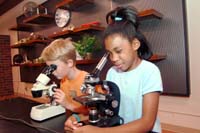 Our Ford Learning Resource Center provides five uncommonly cool classroom environments
that educators and group may reserve to conduct programs or use as
"home base" during group visits. Study in space or be surrounded by six North American biomes. Step back in time in our 19th century Life Sciences classroom or into the future with our high-tech Applied Sciences room. Walk through the infinity mirror into our Physical Sciences classroom.
These classrooms are often used by teachers for school field trips, scout badge programs, overnight camp-ins, workshops, professional teacher development and after-school programs. Our Ford Learning Resource Center provides five uncommonly cool classroom environments
that educators and group may reserve to conduct programs or use as
"home base" during group visits. Study in space or be surrounded by six North American biomes. Step back in time in our 19th century Life Sciences classroom or into the future with our high-tech Applied Sciences room. Walk through the infinity mirror into our Physical Sciences classroom.
These classrooms are often used by teachers for school field trips, scout badge programs, overnight camp-ins, workshops, professional teacher development and after-school programs.
The center's classrooms provide unique educational experiences in five scientific disciplines (click HERE for photographs):
- Space Sciences Classroom - resembles
the interior of a space station and includes a wraparound space
mural.
- Earth Sciences Classroom - features an interactive, wraparound mural that
displays North America's six biomes: coral reef, temperate forest, wetland, grassland,
mountain and desert.
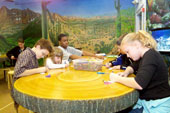
- Life Sciences Classroom - allows students to experience the role of an
amateur scientist in a 19th century era laboratory. The lab combines classic laboratory
equipment with current technology.
- Physical Sciences Classroom - step through the infinity mirror!
Discover the worlds of light, sound, magnetism, electricity, motion and force.
- Applied Sciences Classroom - houses a design lab to allow visitors to design,
engineer and build their vision of the future. It's also a place where computers from IBM
are available for running programs or surfing the Internet.
|
|



